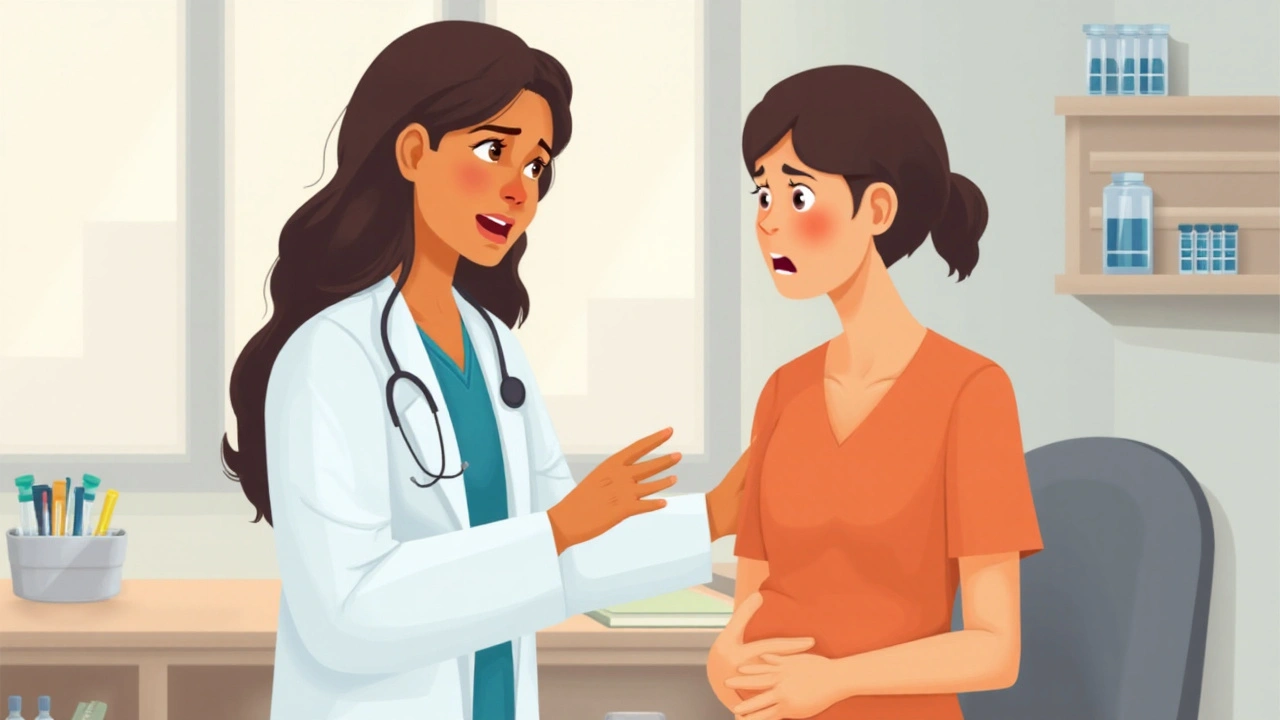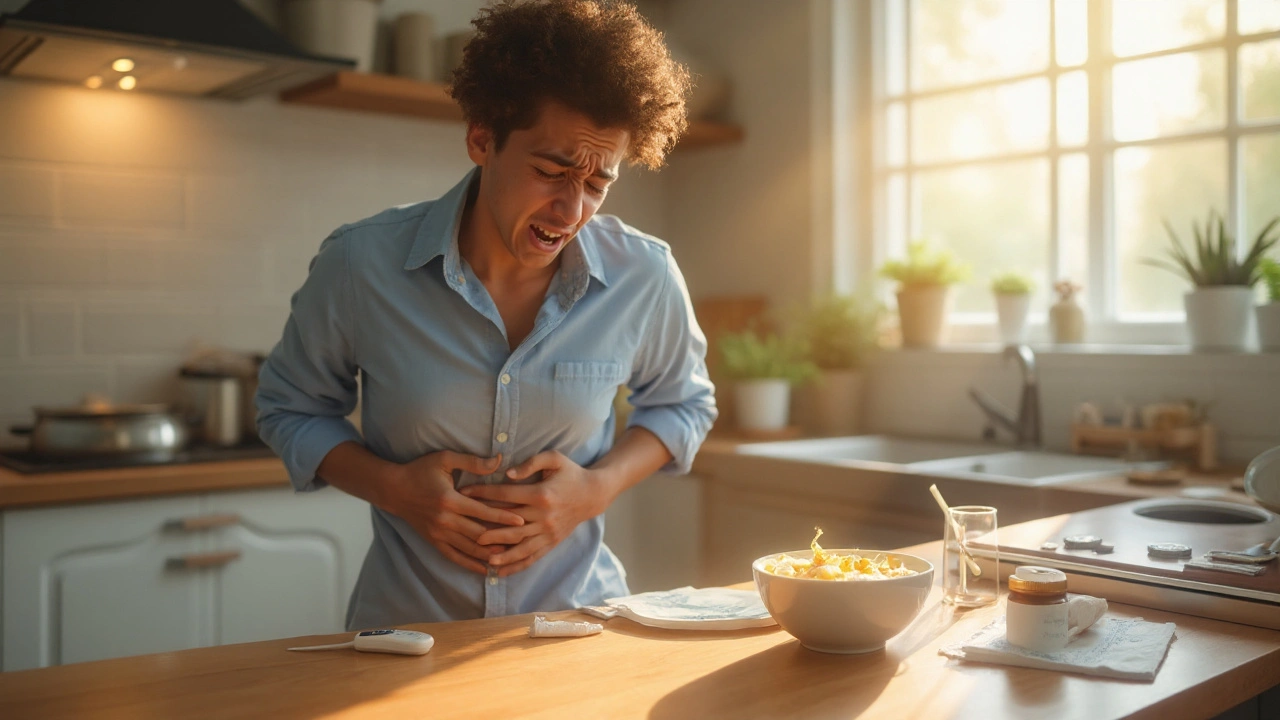Gastroenteritis is a inflammation of the stomach and intestines typically caused by infectious agents, recognized by rapid onset of vomiting, diarrhea, fever and abdominal cramping. When the cramp escalates to a sharp, unrelenting severe abdominal pain, the body is sending a strong alarm that warrants prompt attention.
Why Severe Stomach Pain Is a Red Flag
Not every tummy ache needs a doctor, but pain that feels like a tearing or a constant pressure often indicates that the gastrointestinal lining is inflamed enough to trigger strong muscle contractions. The pain originates from two main mechanisms:
- Inflammatory irritation: Pathogens release toxins that irritate the mucosal layer, causing the nerves to fire pain signals.
- Spasm of the smooth muscle: The gut tries to expel the offending agent, leading to powerful, rhythmic contractions that feel like cramps.
When these processes combine, the resulting pain can be so intense that it interferes with breathing, sleep, or basic daily tasks. Ignoring it risks dehydration, electrolyte imbalance, and in rare cases, perforation of the intestinal wall.
Common Culprits Behind Gastroenteritis
Infections are the leading cause of the condition, and each pathogen brings a slightly different pain profile. Below is a snapshot of the most frequent offenders.
| Pathogen | Incubation (hrs) | Typical Symptoms | Pain Intensity* (1‑5) |
|---|---|---|---|
| Norovirus | 12‑48 | Vomiting, watery diarrhea, low‑grade fever | 3 |
| Rotavirus | 24‑48 | Severe watery diarrhea, vomiting, dehydration | 4 |
| E.coli (ETEC) | 6‑24 | Bloody or non‑bloody diarrhea, nausea | 4 |
| Salmonella | 6‑72 | Fever, abdominal cramps, diarrhoea | 5 |
| Campylobacter | d>2‑5Bloody diarrhea, fever, severe cramps | 5 |
*Pain intensity is a clinician‑derived scale where 1 = mild discomfort and 5 = excruciating cramps.
How Doctors Pinpoint the Diagnosis
A thorough assessment starts with a clinical interview. The clinician asks about symptom onset, travel history, recent food intake, and exposure to sick contacts. Physical examination focuses on tenderness, guarding, and signs of dehydration such as dry mucous membranes or low blood pressure.
Laboratory confirmation usually involves a stool culture or polymerase‑chain‑reaction (PCR) panel. These tests identify viral RNA, bacterial DNA, or parasitic ova, allowing targeted therapy when needed. Blood tests (CBC, electrolytes) gauge the severity of dehydration and rule out complications like sepsis.
In high‑risk patients-infants, elderly, immunocompromised-doctors may order imaging (abdominal ultrasound) to exclude intussusception or perforation, both of which can masquerade as severe pain.
Home Management: What You Can Do Right Now
If the pain is moderate and you’re otherwise healthy, supportive care often clears the infection within a few days. Key steps:
- Rehydrate: Sip oral rehydration solution (ORS) or clear fluids every 15‑20 minutes. Aim for 150‑200ml per hour for adults; children need proportionally less. Dehydration is the main danger and the fastest way to develop it is through continuous diarrhea.
- Rest the gut: Stick to bland foods-bananas, rice, applesauce, toast (the BRAT diet). Avoid dairy, caffeine, alcohol, and high‑fat meals until symptoms subside.
- Control the pain: Over‑the‑counter antispasmodics like dicyclomine or non‑steroidal anti‑inflammatories (NSAIDs) can help, but only if you have no bleeding risk. Acetaminophen is safer for fever and mild aches.
- Monitor warning signs: Persistent vomiting, blood in stool, fever above 39°C, or pain that worsens after 48hours warrants medical review.
For bacterial strains like Salmonella or E.coli, antibiotics are usually reserved for severe cases or immunocompromised patients, as they can prolong carriage in mild infections.

When to Seek Urgent Care
Even with home care, certain scenarios demand immediate attention:
- Inability to keep any fluids down for more than 12hours.
- Severe, continuous pain that prevents normal breathing.
- Blood or mucus in stool, especially in children.
- Signs of shock: rapid heartbeat, cold clammy skin, dizziness.
- High‑risk groups (infants <12months, pregnant women, elderly >75years, or those on immunosuppressive therapy).
Emergency departments will administer intravenous (IV) fluids, provide anti‑emetics, and perform rapid diagnostic testing. Early intervention shortens hospital stays and reduces the risk of long‑term complications like post‑infectious irritable bowel syndrome.
Prevention: Cutting the Risk Before It Starts
Most cases of gastroenteritis are preventable with basic hygiene and safe food practices. Key habits:
- Hand washing: Use soap and water for at least 20seconds after using the restroom, before meals, and after handling raw meat.
- Food safety: Cook poultry to an internal temperature of 165°F (74°C), wash fruits and vegetables thoroughly, and avoid cross‑contamination by using separate cutting boards.
- Safe water: In areas with questionable tap water, boil water for one minute or use certified filtration.
- Vaccination: The rotavirus vaccine is recommended for infants and dramatically lowers severe diarrheal disease.
- Travel precautions: Stick to bottled or treated water, peel fruits yourself, and steer clear of street‑food stalls if you have a sensitive stomach.
By embedding these steps into daily routines, you reduce both the chance of infection and the likelihood that a stomach ache will turn into a painful, dehydrating episode.
Related Topics to Explore Next
If you found this guide helpful, you might also be interested in:
- Understanding post‑infectious irritable bowel syndrome and its link to prior gastroenteritis.
- Managing chronic dehydration in the elderly.
- Choosing the right oral rehydration solution for children.
Frequently Asked Questions
What distinguishes normal stomach upset from gastroenteritis?
A common upset usually resolves within a few hours and lacks fever, vomiting, or watery diarrhea. Gastroenteritis strikes quickly, brings a fever above 38°C, and often includes severe cramps that last more than 24hours.
Can I treat bacterial gastroenteritis at home without antibiotics?
Most mild bacterial infections clear with hydration and rest. Antibiotics are reserved for high‑risk patients, severe dehydration, or infections known to cause complications (e.g., certain E.coli strains).
How much fluid should I drink when I have diarrhea?
Aim for at least 150ml of clear fluid every 15‑20minutes. For adults, that adds up to roughly 2-3liters per day; children need proportionally less based on weight.
Is it safe to use ibuprofen for the pain?
Ibuprofen can worsen stomach irritation and should be avoided if you have blood in your stool or a history of ulcers. Acetaminophen is a safer alternative for fever and mild pain.
When should I consider getting a stool test?
If symptoms persist beyond 48hours, if you notice blood, or if you belong to a high‑risk group, a stool culture or PCR panel helps identify the exact pathogen and whether targeted therapy is needed.
Can probiotics speed up recovery?
Evidence suggests specific strains like Lactobacillus rhamnosus GG can shorten the duration of viral gastroenteritis in children, but they are not a substitute for rehydration.

Victoria Bronfman
September 23, 2025 AT 14:52OMG this is SO relatable 😭 I had norovirus last year and it felt like my intestines were being twisted by a tornado 🌀 I thought I was dying. Also, the BRAT diet is a LIE. I ate banana and it made me vomit harder. Send help. Or just send me Pepto. 🙏
Gregg Deboben
September 24, 2025 AT 14:57This is why America needs better food safety laws. People are getting sick because some jerk in a kitchen didn't wash his hands. We're not in some third-world country where you drink river water. If you can't handle basic hygiene, you shouldn't be allowed near food. #AmericaFirst #CleanFood
Christopher John Schell
September 25, 2025 AT 22:11You got this 💪 Seriously, even though it sucks right now, your body is fighting hard and you're gonna beat this. Hydrate like your life depends on it-because it kinda does. Sip that ORS like it's liquid gold 🏆 And remember: rest isn't lazy, it's legendary. You're not weak-you're healing. I believe in you 🙌
Felix Alarcón
September 27, 2025 AT 09:54Hey everyone, just wanted to say I’ve been through this in Mexico, India, and even right here in the US-gastroenteritis doesn’t care where you’re from. What matters is how we care for each other. I learned that in Lima, an old lady gave me her last bottle of boiled water and a banana. No one asked for thanks. Just kindness. So if you’re reading this and feeling awful? You’re not alone. We’ve all been there. 🌍❤️
Lori Rivera
September 29, 2025 AT 01:44While the information presented is clinically accurate, I must note that the use of informal language and emoticons in this thread detracts from the professional tone appropriate for medical discourse. A more structured, evidence-based discussion would better serve public health understanding.
Josh Bilskemper
September 30, 2025 AT 17:43Storz Vonderheide
October 1, 2025 AT 13:19Josh, I get where you're coming from-STEC is scary and underdiscussed. But not everyone knows the difference between ETEC and STEC, and that’s okay. The goal here is to help people recognize danger signs, not to turn this into a microbiology exam. Maybe we can add a footnote? I’ve got a CDC link that breaks it down simply. Would that help?
Leif Totusek
October 3, 2025 AT 11:17Thank you for the comprehensive overview. I would like to respectfully suggest that the section on home management should explicitly caution against the use of loperamide in cases of bloody diarrhea, as it may prolong pathogen shedding. This is a critical detail often omitted in lay resources.